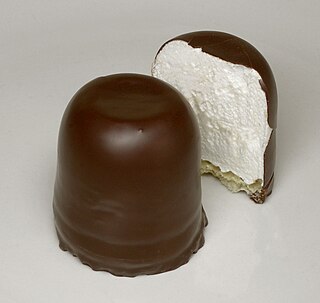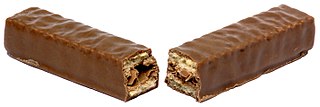
A cookie or biscuit is a baked snack or dessert that is typically small, flat, and sweet. It usually contains flour, sugar, egg, and some type of oil, fat, or butter. It may include other ingredients such as raisins, oats, chocolate chips, or nuts.

Chocolate-coated marshmallow treats, also known as chocolate teacakes, are confections consisting of a biscuit base topped with marshmallow-like filling and then coated in a hard shell of chocolate. They were invented in Denmark in the 19th century and later also produced and distributed by Viau in Montreal as early as 1901. Numerous varieties exist, with regional variations in recipes. Some variants of these confections have previously been known in many countries by names comprising equivalents of the English word negro.

Oreo is a brand of sandwich cookie consisting of two cocoa biscuits or cookie pieces with a sweet fondant filling. It was introduced by Nabisco on March 6, 1912, and through a series of corporate acquisitions, mergers and splits both Nabisco and the Oreo brand have been owned by Mondelez International since 2012. Oreo cookies are available in over one hundred countries. Many varieties of Oreo cookies have been produced, and limited-edition runs have become popular in the 21st century.

A wafer is a crisp, often sweet, very thin, flat, light biscuit, often used to decorate ice cream, and also used as a garnish on some sweet dishes. Wafers can also be made into cookies with cream flavoring sandwiched between them. They frequently have a waffle surface pattern but may also be patterned with insignia of the food's manufacturer or may be patternless. Some chocolate bars, such as Kit Kat and Coffee Crisp, are wafers with chocolate in and around them.

Cadbury Dairy Milk is a British brand of milk chocolate manufactured by Cadbury. It was introduced in the United Kingdom in June 1905 and now consists of a number of products. Every product in the Dairy Milk line is made with exclusively milk chocolate. In 1928, Cadbury's introduced the "glass and a half" slogan to accompany the Dairy Milk chocolate bar, to advertise the bar's higher milk content.
Butterfinger is a candy bar manufactured by the Ferrara Candy Company, a subsidiary of Ferrero, Nestlé. It consists of a layered crisp peanut butter core covered in a "chocolatey" coating. It was invented by Otto Schnering of the Curtiss Candy Company in 1923. The name was chosen by a popularity contest.

Jaffa Cakes are a cake introduced by McVitie and Price in the UK in 1927 and named after Jaffa oranges. The most common form of Jaffa cakes are circular, 2+1⁄8 inches (54 mm) in diameter and have three layers: a Genoise sponge base, a layer of orange flavoured jam and a coating of chocolate. Each cake is 46 calories. Jaffa Cakes are also available as bars or in small packs, and in larger and smaller sizes. The original Jaffa Cakes now come in packs of 10, 20, 30, or 40, having been downsized in 2017 from 12 or 24 per pack.

Reese's Peanut Butter Cups are an American candy by The Hershey Company consisting of a peanut butter cup encased in chocolate. They were created on November 15, 1928, by H. B. Reese, a former dairy farmer and shipping foreman for Milton S. Hershey. Reese left his job with Hershey to start his own candy business. Reese's are a top-selling candy brand worldwide, with more than $2 billion in annual sales generated for The Hershey Company.

Milka is a Swiss brand of chocolate confectionery. Originally made in Switzerland in 1901 by Suchard, it has been produced in Lörrach, Germany from 1901. Since 2012 it has been owned by US-based company Mondelez International, when it started following the steps of its predecessor Kraft Foods Inc., which had taken over the brand in 1990. It is sold in bars and a number of novelty shapes for Easter and Christmas. Products with the Milka brand also include chocolate-covered cookies and biscuits.

Milky Way is a brand of chocolate-covered confectionery bar manufactured and marketed by Mars, Incorporated. There are two varieties: the US Milky Way bar, which is sold as the Mars bar worldwide, including Canada; and the global Milky Way bar, which is sold as the 3 Musketeers in the US and Canada.

Swedish Fish is a fish-shaped, chewy candy originally developed by Swedish candy producer Malaco in the late 1950s for the U.S. market. They come in a variety of colors and flavors.

Kvikk Lunsj is the name of a chocolate bar that was launched by the Norwegian chocolate sweets manufacturing company, Freia, in 1937 and has been sold ever since — with the exception of a period during and after WWII. Between 1941 and 1949, production was halted due to a shortage of sugar and the lack of quality flour. The chocolate consists of four rectangular wafers covered in milk chocolate, with thinner layers of filler made from ground up discarded wafers and bars mixed with chocolate that is put between wafers in order to break the chocolate into pieces easier. The chocolate has been advertised as a "hiking chocolate", and it is often associated with skiing trips in Norwegian culture, especially during Easter vacation, where chocolate is often used to provide extra energy in packed lunches. Kvikk Lunsj is today owned and produced by Mondelez International and sold in Norway, Sweden, and Denmark.

Time Out is a brand of wafer-based chocolate bar manufactured by Cadbury Ireland. It was introduced in the United Kingdom and Ireland in 1992, followed by Australia and New Zealand in 1995. Mainly sold in pairs, it consists of a ripple of milk chocolate between two wafers, smothered in Dairy Milk milk chocolate. The bar was originally sold under the slogan "the wafer break with a layer of Flake". Since 2016 it has been re-branded as a single-bar version called Time Out Wafer. The original bar has been rebranded in Australia, and is now titled “Twirl Breakaway”.

Arnott's Group is an Australian producer of biscuits and snack food. Founded in 1865 by William Arnott, they are the largest producer of biscuits in Australia and a subsidiary of KKR.

Crunch is a chocolate bar made of milk chocolate and crisped rice. It is produced globally by Nestlé with the exception of the United States, where it is produced under license by the Ferrara Candy Company, a subsidiary of Ferrero.
Pesek Zman is an Israeli brand of chocolate bar, manufactured by Strauss Group's Strauss Israel company under its Elite confectionery brand.

Club is a range of chocolate covered biscuits, sold in Ireland under the Jacob's brand name and in the United Kingdom under McVitie's.

A sandwich cookie, also known as a sandwich biscuit, is a type of cookie made from two thin cookies or medium cookies with a filling between them. Many types of fillings are used, such as cream, ganache, buttercream, chocolate, cream cheese, jam, peanut butter, lemon curd, or ice cream.

Kägi Söhne AG is a Swiss confectioner and chocolate producer based in Lichtensteig. The chocolate-covered wafer specialty Kägi fret from the eastern region in Switzerland, Toggenburg, are available in various flavours and are manufactured by Kägi Söhne AG, Toggenburgerwaffeln- & Biscuitfabrik.

















